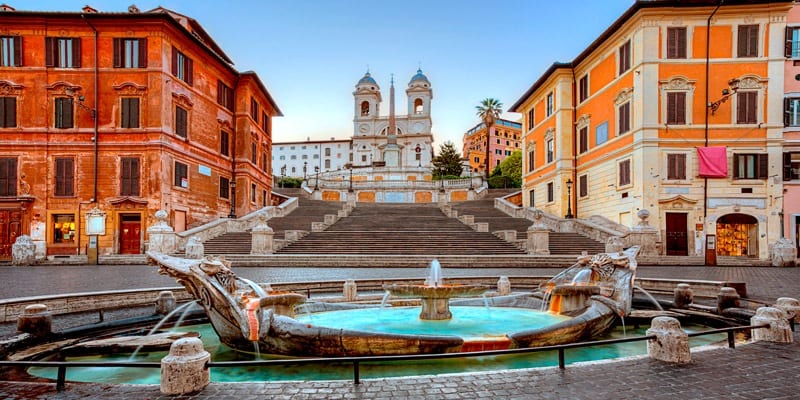 Visit Piazza di Spagna – In one of the most famous films of all time, Roman Holidays, there is a scene in which the two protagonists, played by Gregory Peck and Audrey Hepburn, enjoy an ice cream on the magnificent Scalinata di Trinità dei Monti (better-known as the Spanish Steps). That staircase, leading to the church of Trinità dei Monti, is located in one of the most famous places of the Eternal City: Piazza di Spagna, and consists of 136 steps. Pope Benedict XIII wanted architects Alessandro Specchi and Francesco De Sanctis to design it for the Jubilee in 1725.
Visit Piazza di Spagna – In one of the most famous films of all time, Roman Holidays, there is a scene in which the two protagonists, played by Gregory Peck and Audrey Hepburn, enjoy an ice cream on the magnificent Scalinata di Trinità dei Monti (better-known as the Spanish Steps). That staircase, leading to the church of Trinità dei Monti, is located in one of the most famous places of the Eternal City: Piazza di Spagna, and consists of 136 steps. Pope Benedict XIII wanted architects Alessandro Specchi and Francesco De Sanctis to design it for the Jubilee in 1725.
Visit Piazza di Spagna with the Rome Private Transfer service
Its name comes from Palazzo di Spagna, seat of the Spanish Embassy at the Holy See.
At the center of the square you can admire a well-known and important fountain: the Barcaccia Fountain. The “Barcaccia”, the name by which it is known by most Romans, dates back to the Baroque period and was sculpted by two important artists of the time: Pietro da Cortona and his famous son, Gian Lorenzo Bernini.
Every December 8, Piazza di Spagna hosts a special event: the floral tribute to the statue of the Immaculate Conception, in front of the Iberian embassy. This statue was inaugurated on 8 December 1857.
To visit Piazza di Spagna you can rely on our Rome Private Transfer service
Since 1923 the aerobatic floral tribute to the statue has been made by the body of firefighters. Si nce 1958 this event has also taken a religious significance, as Pope John XXIII attended the cerimony for the first time.
Sinc e then the presence of the Holy Father has become a tradition, faithfully maintained by all the popes. Nowadays this event remains one of the most popular religious ceremonies of the Eternal City.
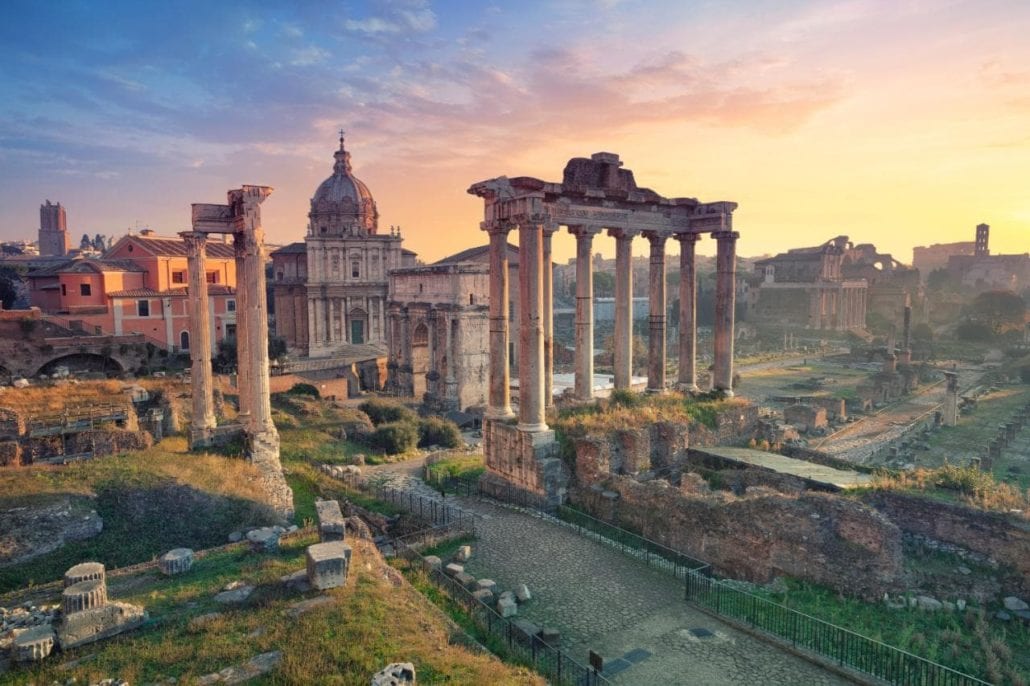
Rome Private Transfer : Visit Roman Forum
Rome Private Transfer : Visit Roman Forum –Democracy was one of the bases of everyday life in ancient Rome. The term “republic” (from the Latin “res publica” which literally means “public thing,” “public matter”) was coined at that time in Rome and was used to refer to the Roman state as a property of all.
Democracy had a symbolic place in Rome: the Roman Forum. This area, enclosed among the Palatine hill, the Campidoglio, via dei Fori Imperiali and the Colosseum, was the hub of political, juridical, religious, economic and social activities of the Roman citizens.
Visit the Roman forum with the Transfer in Rome
Between X and VII century BC, the area of the Forum was used as a necropolis. Shortly after the founding of Rome, dating back to 753 BC, a major battle between the Romans and Sabines (known to history as the Battle of Lake Curzio) took place there.
After its most flourishing era, the imperial period, the area of the Forum had gradually lost its public function and, after the period of ancient Rome, the area was used in different ways. In the 16th century, for example, the Roman Forum was used as a grazing area for cattle and was known as “Campo Vaccino”.
To visit the Roman forum you can rely on our Rome Private Transfer
In the Roman Forum we can still admire the remains of the most important monuments of Ancient Rome. Palazzo Senatorio, the Temple of Vesta, Septimius Severus Arch, the palace of the Curia Iulia (the ancient location of the Senate). For this reason the area is considered one of the most important archaeological sites in the world.
Today the management, protection and enhancement of the heritage of the Roman Forum is entrusted to the Italian public body of the SSBAR (Special Superintendence of Archeology, Fine Arts and Landscape of Rome).

Rome Private Transfer : Visit Trastevere
Rome Private Transfer : Visit Trastevere – Not everyone knows that Rome is not only divided into districts, but also into“ Rioni”; the first level of toponymic subdivision of the historic center area. The “rioni” are 22 and the largest is the thirteenth: Trastevere.
Its name derives from the Latin “trans Tiberim” (translation of “beyond the Tiber”) since it is one of the few located in the west part of the main river of Rome. Since ancient times, its position has made it one of the strategic areas of the city.
Visit Trastevere with the Rome Private Transfer
Shortly after 753 BC, the foundation date of the Eternal City, Trastevere was contended among the city of Rome and some neighboring populations such as the Etruscans of Veii, as it was a strategic point to control the river, Tiberina island and the ancient river port.
The area began to be considered as a real part of the city during the reign of Augustus, but it was the construction of the Aurelian Wall, dated 3rd century AD, that actually brought Trastevere under the administrative control of Rome.
In the eighteenth century, thanks to Pope Benedict XIV, Trastevere acquired the current boundaries.
To visit Trastevere you can rely on our Rome Private Transfer
There are many curiosities and anecdotes linked to Trastevere. Thanks to the partial isolation from the rest of the city and the multicultural environment, the inhabitants of Trastevere, called “Trasteverini”, have almost become a separate population: common people known for tenacity, pride and genuineness .
Many important personalities of Rome lived or were born there. One of the most famuos is the actor Alberto Sordi, known worldwide for masterpieces such as ” An American in Rome “or” The Marquis of Grillo “. Two important and famous squares are dedicated to the poets Giuseppe Gioacchino Bellino and “IL Trilussa”, who described and honored Trastevere, its streets and people, in many of their works.
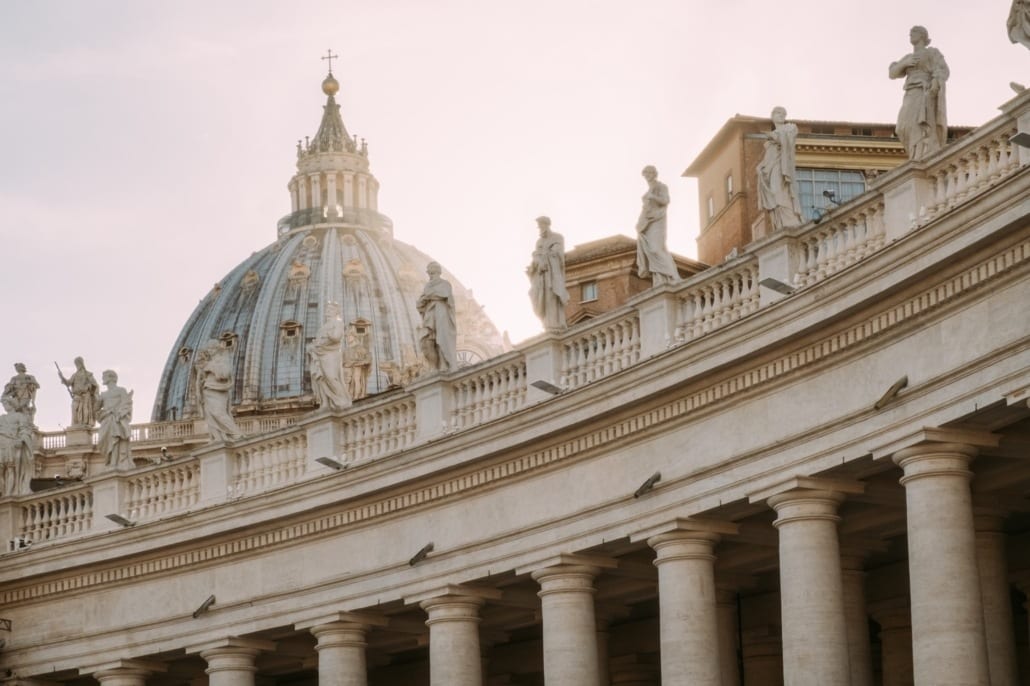
Rome Private Transfer : Visit to Basilica di San Pietro
Rome is a city that some know only for the Roman Empire remains. Romans, during the ancient era, made a small village built on the banks of the Tiber become one of the largest and most famous inhabited centers of all time. The Eternal City, however, is also famous for being the center of Christianity: here, in fact, lies the head of the Catholic church, the Pope, and there are 4 of the 6 most important papal churches in the world.
Visit San Peter church with Transfer Service Rome
Among these the best known is certainly St. Peter, for its size and because next to is the Apostolic Palace (the current residence of the Pope). This basilica, actually, is not part of the Italian state: it is in fact located in the small state of Vatican City.
The most important Christian celebrations (Christmas and Easter, the proclamation of new Popes or the canonization of new saints of the Catholic Christian church) are held there. Over time this Basilica has taken the roman nickname of “Cupolone”, due to its enormous size.
To visit the Basilica of San Pietro you can rely on our Rome Private Transfer
Besides the Basilica, which preserves important artistic works such as the “Pietà” of Michelangelo, it is also important to visit Piazza San Pietro that surrounds it. This square, and its colonnade, were built by architect Gian Lorenzo Bernini in the mid-seventeenth century, under the pontificate of Alexander VII.
The construction of San Peter Basilica began on April 18, 1506, under Pope Julius III and ended in 1626 with Urban VIII.
On the same site, before the current Basilica, rose another built in the fourth century by the Roman emperor Constantine I on the area of the Circus of Nero.
Right there, in a now lost necropolis, according to tradition, was buried Saint Peter, the first of Jesus’ apostles, who was crucifixed around the middle of the first century AD.
Today St. Peter, together with St. Paul, to whom another important basilica is dedicated, is considered one of the Patrons of the city of Rome. They are both remembered on June 29, a patronal feast day for Rome.
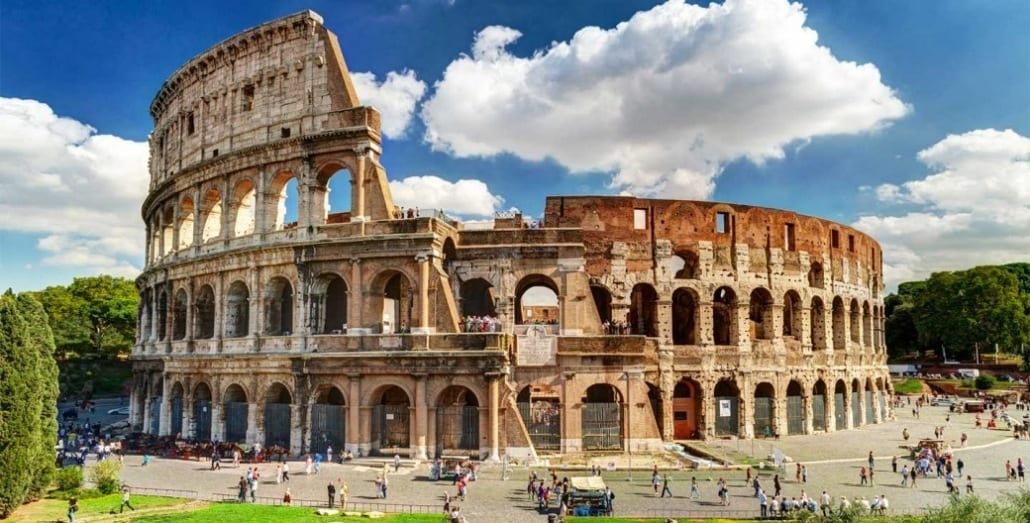
Transfers Rome : Visit to the Colosseum
Transfers Rome – One of the most famous archaeological monuments in the world is certainly the Colosseum in Rome. This amphitheater, which was listed as a UNESCO World Heritage Site in 1980, is considered one of the “new seven wonders of the world” according to New Oper World Corporation.
Visit the Colosseum with Transfers Rome service
Its original name was “ Flavian Amphitheatre”, in honour of the Emperors of the Flavian dynasty who ordered its construction. To be exact, the first stone was laid in 72 AD, during the reign of Vespasian in the eastern part of the Imperial Forum; its inauguration instead took place in 80 AD, when the emperor Titus was in power.
To visit the Colosseum you can rely on our Transfers Rome service
The building has an oval shape with a perimeter of 527 m and a height of 48 m. The name “Colosseum” became widespread in medieval times and probably derives from the colossal bronze statue of Nero that once stood near the amphitheater.
Initially the Colosseum was a leisure place: gladiatorial games, bigas races and other public events took place there. This function was lost during the VI century AD. Since then, the Colosseum has hosted various activities and had different functions.
The Colosseum is considered a real vital organ of the city of Rome. Legend has it that an eighth-century English monk, called Bede the Venerable, said: “As long as the Colosseum exists, Rome will also exist; when the Colosseum falls, Rome will also fall; when Rome falls, the world will fall too “.
To visit the Colosseum you can rely on our Transfers Rome service!

Visit Pantheon
Rome – The Pantheon is an ancient building located in the heart of the Eternal City, exactly in the Capitoline district “Pigna”. Despite its central location, it is one of the least known structures of ancient Rome.
Visit the Pantheon with Transfer Service Rome
The first construction dates back to 27 BC, ordered by Marco Vispanio Agrippa, the son-in-law of the first Roman emperor Augustus. Between 120 and 124 A.D, after being destroyed by several fires, it underwent a series of renovations by Emperor Hadrian.
Its has changed over time: at the beginning it was used as a temple dedicated to all past, present and future divinities ( the etymology of the name derives from the Greek adjective ancient “τό πάνθειον”). From the 7th century AD the Pantheon was converted into a Christian basilica and, since then, it has been renamed Santa Maria della Rotonda or Santa Maria ad Martyres.
To visit the Pantheon you can rely on our transfer service
As a well-preserved example of Roman monumental architecture, the Pantheon was often taken as a model by many European and American architects. Numerous churches, civic halls, universities and libraries from various parts of the world, in fact, echo its structure with a portico and a dome: some examples can be the Basilica of San Francesco in Paola of Naples or the Low Memorial Library of Columbia university in Washington DC
Over the centuries the Pantheon gradually assumed an increasingly pagan purpose. It hosts the tombs of the first two Italian kings: Vittorio Emanuele II and his son Umberto I, and of some important Italian painters; Raffaello Sanzio, for example.
Today this ancient basilica is property of the Italian state, run by the MIBAC (Ministry of National Heritage and Culture).
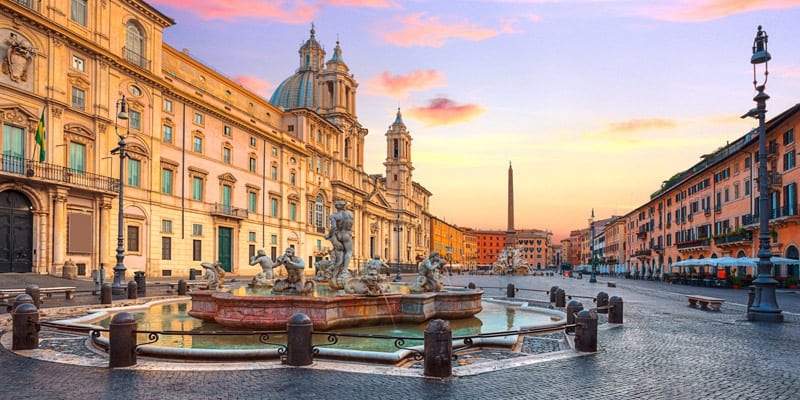
Visit Piazza Navona with Rome Private Transfer
Rome Private Transfer : Visit Piazza Navona – Rome is such a famous city for many reasons: from the remains of ancient monuments, dating back to the Roman Empire, to the cobblestones (sampietrini), and much more; there are so many things that make the streets of the Eternal City unique.
Visit Piazza Navona
The Italian capital is also known for its several and magnificient squares, located in the historic center, but also in the suburbs.
Piazza Navona is among the most beautiful and important ones and the most loved by Romans. Here are some of the most important fountains of the city: for example “the Four Rivers” and the Moor and the Neptune.
The first construction of what later became Piazza Navona, dates back to ancient Rome. In 85 AD, Emperor Domitian built there its stadium. The structure was of impressive dimensions: 276 meters long and 106 wide and could host up to 30,000 spectators.
To visit Piazza Navona you can rely on our Rome Private Transfer
Over the centuries Piazza Navona has gradually lost its recreational function; many of its decorations were taken away and re-used in various ways.
A new life was given to the place in the mid-seventeenth century when Pope Innocent X, member of the ancient Roman noble family “Pamphili”, decided to renovate it. In fact in the square we can admire the ancient official residence of the noble Roman family: Palazzo Pamphili. Today the building hosts the Brazilian embassy in Italy and it is property of the South American state.
Piazza Navona is also one of the finest examples of Baroque in Rome. In fact in the square you can find some works of the most important artists of the time, such as Gian Lorenzo Bernini, Francesco Borromini and Pietro da Cortona.
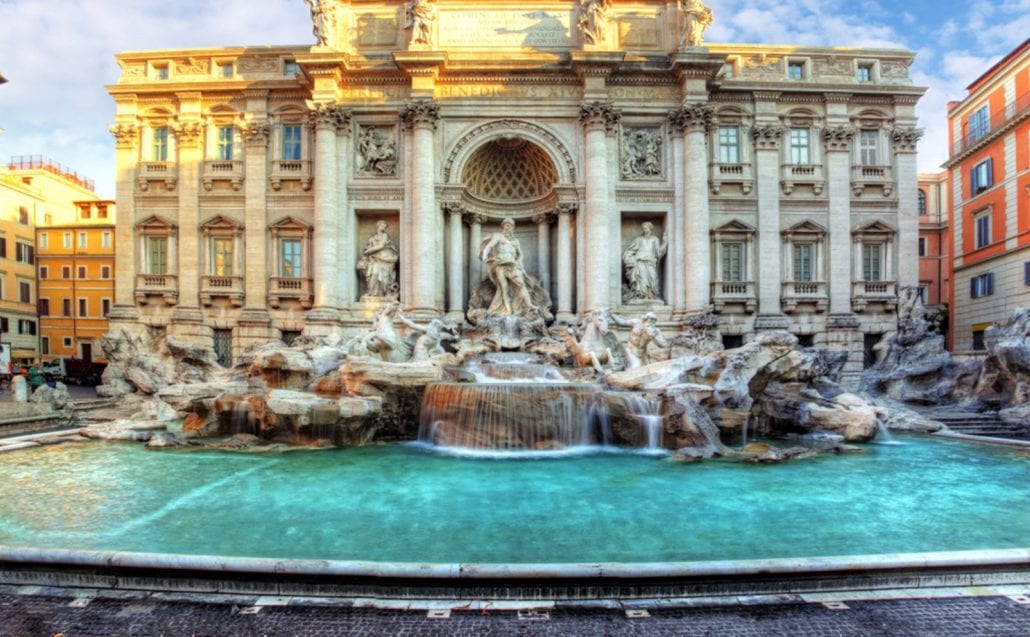
Visit Trevi Fountain
Rome Private Transfer – The “Dolce Vita” by Fellini is one of the most popular movies of all time. Its most famous scene is surely the one that sees the Swedish actress Anita Ekberg taking a bath in the Trevi Fountain in Rome.
The Trevi Fountain is one of the 2000 fountains that adorn numerous streets and squares of the Eternal City. The ancient Romans, in fact, managed to build an ingenious water network for their city, including numerous aqueducts and spas, which can still be admired today.
Visit Trevi Fountain with the Rome Private Transfer
To be specific, the Trevi Fountain was designed in 1731 by architect Nicola Salvi and commissioned by Pope Clementino XIII. Its construction started in 1732, under the supervision of Salvi himself, and ended in 1762 with the architect Giuseppe Pannini.
The “Fontanone”, the nickname given to it by the inhabitants of Rome, is next to Palazzo Poli and was built with travertine, marble, plaster, stucco and metals. Its history is closely linked to the aqueduct of the Virgin Water, one of the most important aquifers of imperial Rome, built at the time of Emperor Augustus, which led water resources to the central area of Campo Marzio.
To visit Fontana di Trevi you can rely on our Rome Private Transfer
The central theme of the fountain is the sea. The water gushes from several points and in the central niche we can admire the statue representing the god Oceano: the divinity of all the waters according to ancient Greeks.
There are many traditions associated with the Trevi Fountain, since it is one of the best known symbols of the city of Rome. For example there’s a long-standing tradition about throwing coins in the Trevi Fountain. The original legend says that if you throw a coin into the Trevi – with your back to the fountain, throwing the coin with your right hand over your left shoulder, keeping your eyes closed – that will ensure a return to Rome.





